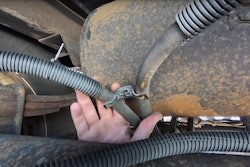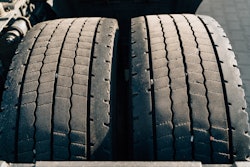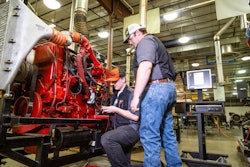The success of the aftertreatment system relies heavily on the diesel particulate filter (DPF), and cleaner, hotter-burning engines are putting more stress on a component that, while expensive, is also increasingly difficult to find.
Joining Jason and Matt this week on CCJ's 10-44 is Keith Shaw, Global OEM Manager for Chevron Lubricants, who says the evolution of the diesel engine has prompted a shift in not just how components support the engine, but also in how they support the aftertreatment.
Contents of this episode
00:00 Engine operating temperatures02:48 Reducing emissions
04:24 Increased oil consumption and DPF problems
06:00 Oil consumption and ash
08:04 Soot and your DPF
08:41 DPFs are going to be harder to get
Video transcript
Jason Cannon
The evolution of a clean diesel engine is going to have an even more significant impact on your DPF.
Hey, everybody, welcome to the 10-44, a weekly episode from the editors here at CCJ. I'm Jason Cannon. And my co-host on the other side is Matt Cole. If you think back to the pre EPA days through today, the diesel engine has undergone a significant amount of change. First, an SCR system was strapped on, then OEM started getting more power per liter, which allowed some fleets to go from 15 liter power to 13 liter footprint. All this raises operating temperatures, which is good for the after treatment, but it's not so good for a lot of other things.
Matt Cole
Engines run more efficiently at hot temperatures, which is good for the engine, but higher temps are not necessarily good for the engine oil. Keith Shaw Global OEM Manager for Chevron Lubricants says "The evolution of the diesel engine has prompted a shift in not just how components support the engine, but also in how they support the after treatment."
Keith Shaw
In the past, right? In the past, we tend to focus on the engine only, right? We're dealing with lubricants and engine oil formulations, and then they start coming in with the after treatment system. So, we got to account for that, but really it was trying to do as little harm as possible to the after treatment system. That's why you saw a 1.0% ash limit when you had CJ-4 introduction, API CJ-4. But now it's starting to be a different game and as formulators, we're really not only trying to formulate for the engine but formulate for the after treatment systems that are coming in, because they're going to get more sophisticated. Today, its typical setup is when you look at your after treatment system, you have a diesel oxidation catalyst, your DPF, and FTR, maybe a ammonia slip catalyst, et cetera, and could or could not have an EGR, some OEMs are looking to do away with that.
But that's kind of the system that you have, but in going forward as we near 2027, there's several changes that are happening. So, your viewers or listeners are aware of carb and their Omnibus low NOx rule, which is going to start taking effect in 2024, and that's pretty aggressive. PC-12, which is coming in 2027, again is focusing on even more stringent oxidation control limits as well as wear for the lower viscosities because we're going to be introducing 5W-20, maybe 0W-20 in some places, right? For some OEMs. And all that has to work in conjunction with helping the after treatment system and working properly.
Jason Cannon
Carbs Omnibus regulations starting in 2024 would require among other things that heavy duty engine manufacturers develop and deploy technologies that reduce nitrogen oxide emissions initially by 75% and particulate emissions by 50%. All of that is going to require more after treatment refinement and engine technologies.
Keith Shaw
So, what OEMs are looking at is maybe adding a secondary SCR upstream. So, then you'll now you'll have a second one SCR system before your DOC DPF and then you'll have another SCR after that, which is going to drive right increase in DEF usage and what have you. And all of this is targeted for lowering greenhouse gases, which you also have standards coming in from the federal side by 2027 of close to 15% fuel economy benefit. When you look at the oil formulation and what we're looking at now, we're dealing with yes, we're dealing with much lower viscosities.
Keith Shaw
API has agreed on what they call Proposed Category 12 or PC-12, that will be targeted for 2027 release as well. That will include some lower viscosities and some lower high temp high shear rates. The after treatment systems are really at the forefront of when we're formulating oils, what we have to think about. Whereas, I think in the past it was in the background, it was something let's just not harm it. Let's just kind of design around it. Now, it's really treated as a system between engines and the after treatment systems and we have to look at everything when we're formulating today.
Matt Cole
A lot of the ash that gets trapped in the DPF comes from the combustion of engine oil. And as these newer model year engines are asked to do more, that could increase consumption and lead to problems with the DPF.
Keith Shaw
Being able to control oil consumption is a big deal. And so, as oil consumption increases, you're going to see increased ash. And why some of the focus has been on let's say oxidation control, has these engines run hotter, [inaudible 00:04:52] a leading cause of increased oil consumption are piston deposits. You piston deposits, the rings are ceiling as well, not moving and oil consumption goes up, and that can be a significant issue. The same thing goes to say with viscosity shear rates, so lower viscosity oils, I mean just common sense, right? A lower viscosity oil tends to be a higher oil consumption I have. So, that requires a lot of big technology for OEMs to control on some of these super low visc products on oil consolidation. Because the engines are expected to do more, we tend to consume a little bit more oil and that's going to be trouble for the DPF.
Jason Cannon
Electrification gets most of the headlines, but there are diesel solutions out there that offer lower emissions. In the case of a renewable diesel, there's plenty of data out there that says not only is the fuel itself comparable to regular diesel, but it keeps the DPF cleaner. But that's not necessarily true. Biodiesel for example, has a better cetane number than Petro diesel. So, it produces less soot but it doesn't address at all oil consumption, and that's what really impacts the ash.
Keith Shaw
Now what's kind of an interesting discussion on DPS and alternative fuels is biodiesels and renewable diesels not really, but biodiesels can contain potassium or sodium. It's just part of the process of what they have. And while it can be low in the concentration levels, let's say five, 10 PPM, something like that. The amount of fuel that gets burned over the life of the DPF is not, it's not insignificant. It's typically 80, a hundred times what you see in oil consumption is going through that DPF. So, relatively low levels, let's say for biodiesel of sodium potassium, which are ash components can lead to accelerated DPF ash buildup.
Matt Cole
A reduction in soot sounds like a good thing, but the sequence of things that happen in the DPF relies on a predictable ratio of all the things that's designed to catch. Keith tells us how less isn't always better right after this word from 10-44 sponsor Chevron Lubricants.
Jason Cannon
Protecting your diesel engine and its after treatment system has traditionally been a double edged sword. The same engine oil that is so essential to protecting your engine's internal parts is also responsible for 90% of the ash that is clogging up your DPF and upping your fuel and maintenance costs. Outdated industry thinking still sees a trade off between engine and emission system protection and Chevron was tired of it. So, they spent a decade of R&D developing a no compromise formulation. Chevron Lubricants developed a new ultra low ash diesel engine oil that is specifically designed to combat DPF ash clogging.
Delo 600 ADF with OMNIMAX technology cuts sulfate ash by whopping 60%, which reduces the rate of DPF clogging and extends DPF service life by two and a half times. And just think what you can do with all the MPGs you're going to add from cutting your number of regions. The Delo 600 ADF isn't just about after treatment, it provides complete protection, extending drain intervals by preventing oil breakdown. Before you had to choose between protecting your engine or your after treatment system, and now you don't. 600 ADF from Delo with OMNIMAX technology, it's time to kick some ash.
Keith Shaw
Now, when you start to introduce let's say a renewable diesel or something like that, and you're producing less soot, we've changed that ratio of soot to used oil, to other contaminants in that DPF that now have to get ignited and it may not burn as hot. And if it doesn't burn as hot, it doesn't get rid of all the soot maybe, and maybe there's inefficient burn. And there's some studies that have looked at it and said, well, really the size of the ash particles are starting to vary maybe, and it could be bigger.
Jason Cannon
Extending the life of your DPF not only makes a lot of business sense, it also removes a sourcing headache. SCR is going global and DPFs are going to be harder to get.
Keith Shaw
You've had some major shifts in emission regulations around the world. Europe went to stage five for off highway and that really mandates a DPF. And for even going down to smaller horse power size and up, and China has launched their national six, which is on highway that was in 2019. And coming up December this year, they're going to do their China stage four, which will require DPFs on all non roads or all highway equipment. And India is doing the same thing, right? With their stage six and on road stage four. And all of this is putting pressure on DPF demand.
But kind of in perspective, China and India together produce about one and a half million heavy duty trucks a year in that DPF and even in the DOC and the SCR systems, a lot of precious metals, primarily platinum and palladium. And obviously with issues that are happening around the world, Russia, China, a lot of those precious metals are coming from Russia. And so, it's rather unique supply chain challenge. Now, couple that with the fact that you've got OEMs that are out there saying maybe we're recommending that you clean the DPF one time and after that one time, buy a new DPF.
Jason Cannon
That's it for this week's 10-44. You can read more on CCJdigital.com. And as always you can find the 10-44 each week on CCJs YouTube channel. And if you've got questions, comments, criticisms, or feedback, please hit us up at [email protected] or give us a call at 404-491-1380. Until next week, everybody stay safe.











